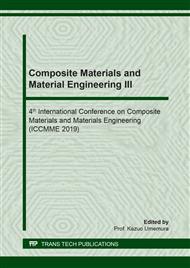p.371
p.377
p.385
p.391
p.397
p.404
p.410
p.416
p.424
Influence of Glass and Limestone Powders in High Calcium Fly Ash Geopolymer Paste on Compressive Strength and Microstructure
Abstract:
The effects of replacing high calcium fly ash with containment glass powder and limestone powder in the geopolymer are investigated in this paper. The high calcium fly ash was replaced by either glass powder or limestone powder at 20% and 40% by weight. The geopolymer paste was tested for setting time and compressive strength and evaluated of its microstructure on SEM, XRD, FTIR, and MIP. The results indicated that the setting time of geopolymer paste was increased with the replacement of glass powder and reduced by replacement of limestone powder. The compressive strengths were generally higher than those of controls. The maximum increase of compressive strength was 33% when replaced fly ash with 20% of glass powder at 8 molar NaOH concentration of sodium hydroxide solution. The microstructure evaluations show the remaining particles of raw materials and the compatible of hydration reaction and polymerization when having limestone powder in the mix proportion. Furthermore, the powder acts as a filler in the gels.
Info:
Periodical:
Pages:
397-403
Citation:
Online since:
May 2019
Price:
Сopyright:
© 2019 Trans Tech Publications Ltd. All Rights Reserved
Share:
Citation:


